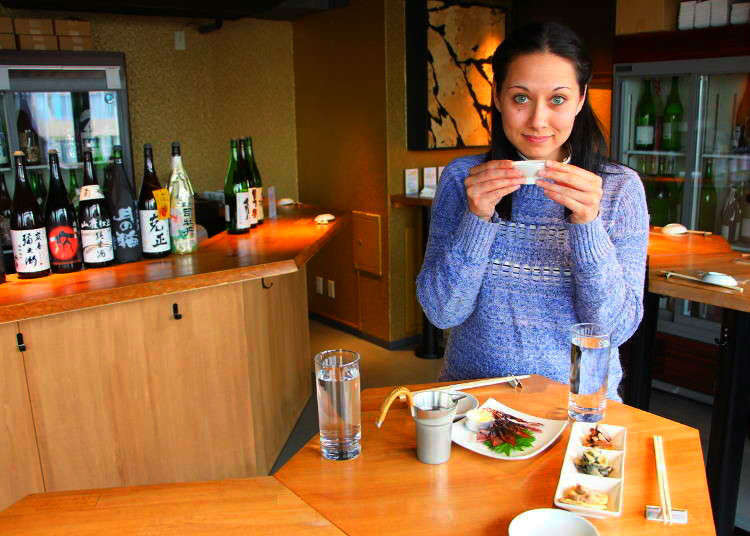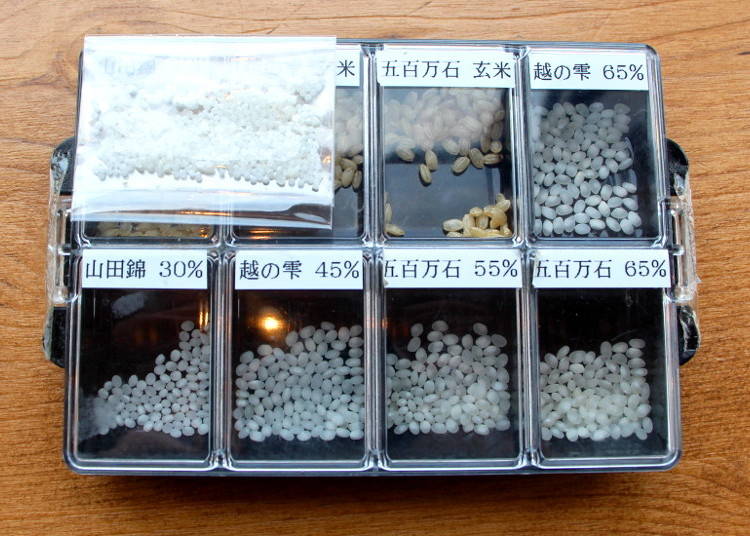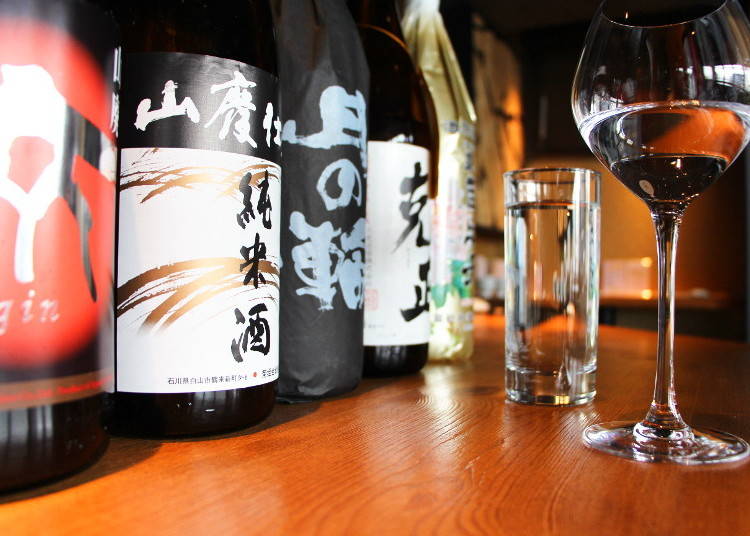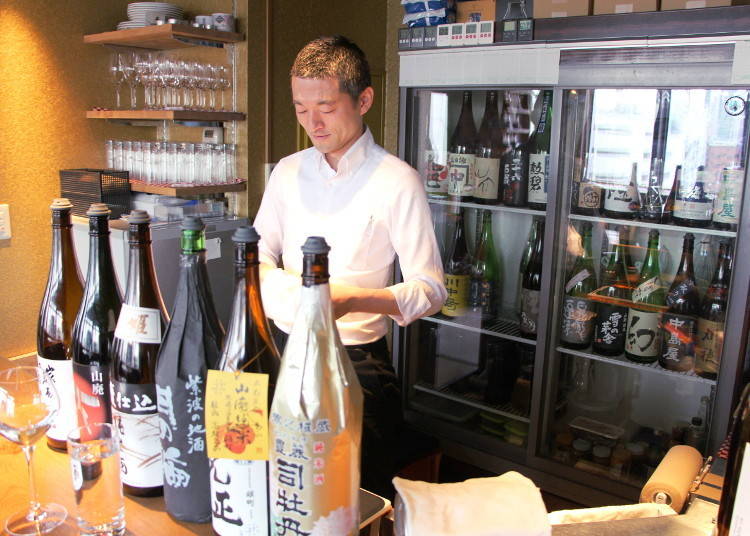
Japanese sake, the national beverage born from tiny grains of rice. Also known abroad as Japanese rice wine or nihonshu, sake has become popular all around the world in recent years, and can be found in many stores, bars, and restaurants even outside of Japan!
But within Japan, the selection of different kinds of sake can quickly become overwhelming. Nonetheless, a visit to a Tokyo sake bar is a must when wanting to explore the many secrets of the unique drink – and you might just get lost in the mysterious world of Japanese sake.
What is Japanese Sake?

Japanese sake is an alcoholic drink made from the ingredients water and rice, created through the technique of fermentation. It has an alcohol content of around 15% when water is added, and between 16% and 19% when straight. Japanese sake, however, is available in all kinds of varieties, such as diluted, easy-to-drink types with an alcohol content of just 5%, but also straight Japanese sake below 15%.
In general, there are two kinds of sake. One that has only rice, kome-koji (rice koji, malted rice), and water on its label is called junmai-shu, or sake without any added alcohol or other ingredients. If distilled alcohol is also listed as an ingredient, it is alcohol tenka-shu.
Made from ingredients such as molasses or corn, distilled alcohol is a taste- and odorless liquid. People often seem to believe that adding alcohol is somewhat unnatural but the use of distilled alcohol doesn’t say anything about the quality of the Japanese sake. Moreover, it is used to lighten the taste and to bring out the aroma of the spirit.
Japanese sake is generally said to be sweet but of course not like drinks such as juice or soda. The sweetness comes from the sugar contained in the rice so it can be said that rice is responsible for the umami – or flavor – of the drink.
Depending on the brewer’s method and recipe, Japanese sake can be dry or sweet, have a very subtle flavor or a particularly strong one. You see, there are plenty of sake available and once getting a taste, it is likely to never let you go again!
A Beginner’s Guide to Japanese Sake Bars

Although not strictly defined, “sake bar” refers to a place that features an expert on Japanese sake to both manage and serve the different spirits. Such a bar offers sake from all around Japan and offers its guests to savor and compare a wide variety of sake.
You might get the impression that these sake bars are filled with connoisseurs who exchange educated opinions but don’t worry – sake bars are a welcoming place for sake beginners and there is much and more to discover!
Even Japanese people generally don’t know much about sake. Should it be bought in a specialty store or at the supermarket? Is this dry or sweet? Should it be enjoyed warm or chilled? Should sake be stored in a fridge, does it have an expiration date? People hesitate to buy Japanese sake as they don’t know how to drink and store it, and often don’t know how and what to order from the sake menu of a restaurant.
The experts at sake bars will let you try a variety of different sake while entertaining you with their vast knowledge surrounding the spirits, guiding you find the one or other sake that suits your taste the most. The fun, relaxed atmosphere this creates, though, is one of the sake bar’s best characteristics.
Driven by both passion and a sense of crisis, Japanese sake brewers agree: we mustn’t let sake culture die out. With this conviction, they send out their sake products made from choice ingredients and methods to wholesalers, liquor stores, and sometimes directly to sake bars where the spirits are properly handled and served by Japanese sake experts. Savoring the excellent flavors of sake, maintained in such proper conditions, is one of the biggest draws of a Japanese sake bar.
How to Find a Sake Bar

Generally, sake bars can be found in the lively gourmet districts of a city, as well as in large commercial facilities. In Tokyo, particularly around major and terminal train stations such as Shinjuku, Shibuya, or Ikebukuro, attracting a colorful variety of guests who come and go as they please.
To find your very first bar, asking the concierge of your hotel is a good idea, as well as searching social media (especially Instagram) for the keyword and hashtag “#sakebar.”
The majority of sake bars are very small so they are often on Facebook and Instagram as these are cheap and reliable methods to showcase one’s place and be in contact with one’s guests. Another worthy thing to check are the accounts and blogs of sake connoisseurs and see what bars they recommend.
Sake is a delicate drink with every bottle being handled differently, and every cup is best enjoyed in its own way. Rather than just choosing by popularity and number of offered sake types, we highly recommend going to a bar that employs a Japanese sake expert and one where people just come in for a drink without lingering at the bar for a long time. At these bars, the sake is always checked to be in top condition and due to the constant coming and going, the number of customers is large and it is thus even more guaranteed that the taste of an opened sake bottle doesn’t deteriorate.
One last tip: don’t hesitate to chat to the other guests and the barkeeper, as they’re generally more than happy to share their sake and bar recommendations with kind spirits!
Having learned more about what Japanese sake and a sake bar is, let’s make sure that your first visit to such an establishment is as enjoyable as possible by exploring the etiquette, system, and how to order your perfect cup with common expressions and phrases surrounding Japanese sake - give the following link a tap!
Writer: MIDORIKAWA Emiko
Book a Sake Experience
Related Links
- Area
- Category
*Prices and options mentioned are subject to change.
*Unless stated otherwise, all prices include tax.
Popular Tours & Activitiess
Recommended places for you
-

The Ultimate Guide to Mitsui Outlet Parks in Japan (2025 Edition) - Popular Tax-Free Malls & Coupon Info for Travelers
-

See Asakusa and Tokyo Skytree® in a New Light at the "Také Akari" Festival (Winter 2025-2026)
by: Guest Contributor
-

2025 Japan Autumn Color Report: Northeastern Japan Nearing Peak
by: Timothy Sullivan
-

2025 Autumn Colors Report: Kurobe Gorge Nearing Peak
by: Timothy Sullivan
-

Fine Dining on Rails? Japan Announces Stunning NEW 'Laview' Restaurant Train
-

A Don Quijote Like No Other: Step Inside the All-New Tourist-Friendly Store at Shinjuku Tonanguchi Bekkan
by: Chehui Peh
Inspiration for Accommodations
-

Enjoy Mt. Fuji from the Comfort of Your Room! Recommended Ryokan with Mt. Fuji View
-

Stay Near the Cherry Blossoms! Hotels for Cherry Blossom Viewing in Tokyo
-

Family-Friendly Hotels with Free Shuttle to Disneyland: Convenient Access for a Magical Stay
-

Top Ranked Hakone Hotels with Mt. Fuji View: Enjoy Stunning Scenery from Your Private Space
-

Convenient Tokyo Hotels with Airport Shuttle: Ideal for Families and Heavy Luggage
-

Stunning Tokyo Tower View Hotels: Enjoy Spectacular Scenery from Your Private Space
-

Convenient Asakusa Hotels with Kitchens: Ideal for Extended Family Visits
-

Experience Luxury: Hakone's 10 Best Five-Star Accommodations
-

Enjoy Mt. Fuji Autumn Leaves! Top Hotels Near the Popular Autumn Leaves Corridor
-

Experience Hakone Fall Foliage from Your Room with Stunning Views
-

6 Fun Things to Do at Tokyo's World-Famous Tsukiji Outer Market!
-

The proper way to walk the Golden Street
-

Tokyo Roppongi|Roppongi Station Area Map & Sightseeing Information
-

Ueno Station Area Guide: Fun Ways to Explore Tokyo's Popular Destination (Area Map & Sightseeing Tips)
-

Nightlife in Tokyo
-

Japan Awesome Bar Guide: Inside 9 of Tokyo's Best Bars!
- #best ramen tokyo
- #what to buy in ameyoko
- #what to bring to japan
- #new years in tokyo
- #best izakaya shinjuku
- #things to do tokyo
- #japanese nail trends
- #what to do in odaiba
- #onsen tattoo friendly tokyo
- #daiso
- #best sushi ginza
- #japanese convenience store snacks
- #best yakiniku shibuya
- #japanese fashion culture
- #best japanese soft drinks






















